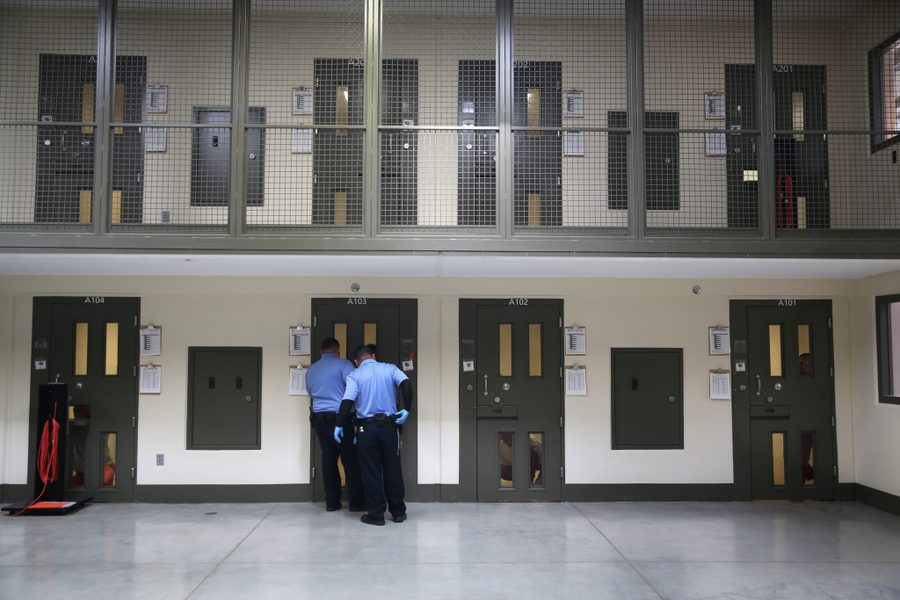Under Biden, Private Detention Isn’t Ending—It’s Changing Form
The Biden administration promised to end private prisons. Instead, it has allowed them to be converted into immigration detention facilities.
Joshua Leach and Hannah Hafter

Last year, a former federal prison near Folkston, Georgia was emptied after President Biden signed an executive order phasing out the use of private prisons. So why is business now booming at the same facility for GEO Group, one of the nation’s largest private prison firms? Because the administration has pulled a sneaky sleight-of-hand: Rather than fully halting the incarceration of people in such facilities, it has allowed them to simply be converted into immigration detention spaces.
This is an appalling reversal from the administration’s earlier promises. After all, Biden came into office with bold pledges to scale back the use of for-profit incarceration of all kinds. Within days of the president’s inauguration, he appeared to follow through on this promise by issuing an executive order purporting to end the use of private prisons to hold people in federal criminal custody.
However, Biden’s order left at least one major loophole: It was silent on the use of private contractors to detain immigrants in civil custody. There was reason to hope a similar order barring privatized immigration detention might follow, as Biden pledged on the campaign trail to “end for-profit detention centers,” as part of his immigration platform. And last April, he claimed that he would make good on this commitment within five days.
In the roughly 300 days that have passed since then, however, private detention has not ended — it has metastasized. In many ways, immigration detention is filling the gap in the federal incarcerated population left by Biden’s order. The expansion of the Folkston facility, for instance, would make it one of the largest such immigration detention facilities in the country.
The Biden administration has taken a few positive steps to address the particularly harmful forms of immigration detention, such as the confinement of asylum-seeking families. But for each step forward, there have been several steps back. In the case of family detention, for example, the sites where family units were confined haven’t closed down, but merely been repurposed. One of them — a facility in Berks County Pennsylvania, which for years held asylum-seeking mothers and children — has now reopened as a facility for detaining single adult women.
This is part of a pattern. If a facility is emptied for a time, but never shuttered, it is almost certain to eventually be refilled by another detained population. After Louisiana took positive steps to reduce the number of incarcerated people in its parish jails, for instance, many of these facilities simply switched over to detaining immigrants. The availability of such detention sites creates a powerful incentive to find ways to fill them, regardless of the stated rationale.
Far from reducing the use of immigration detention, Biden’s order on private prisons left an opening to expand it — and the statistics bear this out. The number of people in Immigration and Customs Enforcement (ICE) custody has climbed since Biden took office. This is especially concerning in the midst of a public health crisis known to spread in detention settings. During the most recent wave of Covid-19 infections, diagnoses surged in ICE custody, causing at least 11 deaths.
Medical neglect was among the concerns that prompted Biden’s original executive order barring privatized facilities in a federal criminal context. If members of the administration knew these dangers, why would they allow tens of thousands of people to remain in privatized immigration lock-ups during a pandemic?
The administration would undoubtedly claim that it’s making efforts to reduce immigration detention over time. A recently-announced pilot program, for instance, would essentially confine people at home instead of in crowded detention centers.
Yet such a policy is merely detention by another name. According to the latest reporting, the contract to implement the pilot has been awarded to none other than GEO Group — one of the nation’s largest for-profit prison contractors operating immigration detention sites, including the one in Folkston.
Even under a policy that confines asylum-seekers at home instead of in traditional detention complexes, corporate actors will continue to “profit from the suffering of desperate people fleeing violence,” as Biden promised to prevent in his campaign pledge to end for-profit detention centers.
Ending the use of private prisons in the criminal legal system must be paired with vigilant efforts to combat their use against immigrants. Otherwise, taking on the prison-industrial complex will be like fighting the hydra: cut off one of its heads and two more will arise.
Joshua Leach is a public policy and communications strategist at the Unitarian Universalist Service Committee (UUSC). Hannah Hafter is a senior grassroots organizer at UUSC, specializing in migrant justice.




